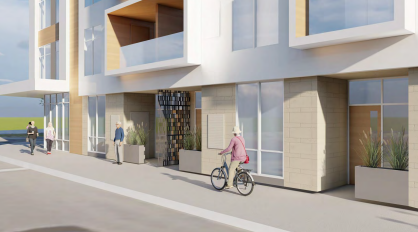GRAND RAPIDS, Mich — City leaders in Grand Rapids say a new development could help address a growing housing crisis. However, others argue it may end up creating a different kind of headache when it comes to parking.
The project in question would bring a mixed-use project to the corner of Plainfield and Quimby in the Creston Neighborhood. The majority of the four-story, 45,000-square-foot building would consist mostly of micro-units, which are smaller apartments of 475-square-feet or less, making it possible to put more of them into a building.

"There's quite a bit more unit in that box, that building than what the density allowances would have otherwise allowed, had there not been the inclusion of micro-units," says City Planning Director Kristen Torklson.
To move this project along, the developer was granted their request to not meet the number of parking spaces a typical project of this size would require.
"They do have to earn that waiver. And that can be earned through a variety of ways. bike parking, access to transit district a proximity to business district parking as well," said Torklson.

The Grand Rapids Planning Commission District also granted the developer parking that many businesses share on Plainfield, something that's of concern to residents and businesses in the area.
"I left for an hour, and I came back with picking up my daughter and all the parking spots were full. I lost my parking spot," resident Rebecka Lua told FOX 17 about the struggle to find spots in the area.
"It's already often very full, especially in the evenings. For us, our customers park, you know, obviously want to park pretty close to the door," says Karen Kloostra, Co-Founder of Stonesthrow.

Kloostra wants her customers to have easy access to parking, so she says she pays to use the city-owned parking lot behind her business, which is the same one the new development would use.
This project is still early in its development, but the city looks at this project as a way contend with the housing shortage.
In October, FOX 17 reported on the city being behind on its own goals of creating 9,000 additional housing units by 2025. City leaders say, developments like the one being discussed for the Creston Neighborhood would help fill that gap.
"So, if we have that need for housing, you know, as a planner, I look at it and go, 'well, where does it go?' And I think it makes a lot of sense when you put higher density development, on transit lines in business districts," said Torklson.

Torklson adds the success of the Creston Development could lead to similar ones being used elsewhere in the city, especially in areas that are highly walkable.
"We have several traditional business areas within the city. So Creston Business District is one of them, of course, Wealthy St., Cherry Street, West Leonard, as well," said Torklson. "Those are kind of the low hanging fruits, if you will, those are the spaces that we want to see and add those density, the needed density for our city."
Another high-density area where micro-unit housing could potentially be seen is Downtown Grand Rapids.
Torklson says back in 2016, the city stopped requiring developers to meet parking requirements for that part of Grand Rapids.




